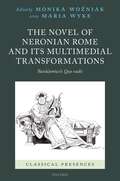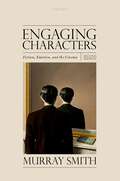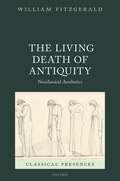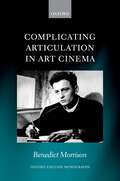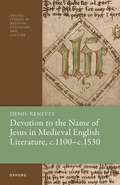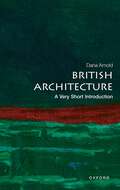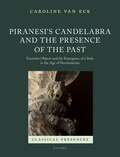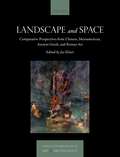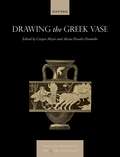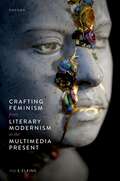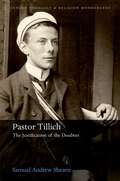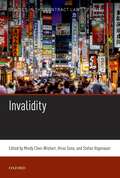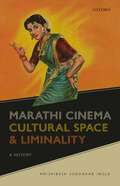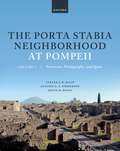- Table View
- List View
The Novel of Neronian Rome and its Multimedial Transformations: Sienkiewicz's Quo vadis (Classical Presences)
by Maria Wyke Monika WoźniakThe Polish writer Henryk Sienkiewicz was awarded the Nobel Prize for literature in 1905 largely on the basis of his historical novel Quo vadis: A Narrative of the Time of Nero. The novel's vivid and moving reconstruction of religious persecution and struggle against tyranny catapulted its author into literary stardom. But, before long, Quo vadis began to 'detach' itself from the person of its author and to become a multimedial, mass culture phenomenon. In the West and in the East, it was adapted for stage and screen, provided the inspiration for works of music and other genres of literature, was transformed into comic strips and illustrated children's books, was cited in advertising, and referenced in everyday objects of material culture. This volume explores the strategies Sienkiewicz used to recreate Neronian Rome and the reasons his novel was so avidly consumed and reproduced in new editions, translations, visual illustrations, and adaptations to the stage and screen across Europe and in the United States. The contributions render visible for English-speaking readers the impact of a Polish work of high literature on the presence of Nero, Christian persecution, and ancient Rome in Western popular culture.
Engaging Characters: Fiction, Emotion, and the Cinema
by Murray SmithCharacters - those fictional agents populating the fictional worlds we spend so much time absorbed in - are ubiquitous in our lives. We track their fortunes, judge their actions, and respond to them with anger, amusement, and affection - indeed the whole palette of human emotions. Powerfully drawn characters transcend their stories, entering into our imaginations and deliberations about the actual world, acting as analogies and points of reference. And yet there has been remarkably little sustained and systematic reflection on these creatures that absorb so much of our attention and emotional lives. In Engaging Characters, Murray Smith sets out a comprehensive analysis of character, exploring the role of characters in our experience of narrative and fiction. Smith's analysis focuses on film, and also illuminates character in literature, opera, song, cartoons, new and social media. At the heart of this account is an explanation of the capacity of characters to move us. Teasing out the various dimensions of character, Smith explores the means by which films draw us close to characters, or hold us at a distance from them, and how our beliefs and attitudes are formed and sometimes reformed by these encounters. Integrating these arguments with research on emotion in philosophy, psychology, evolutionary theory, and anthropology, Engaging Characters advances an account of the nature of fictional characters and their functions in fiction, imagination, and human experience. In this revised, twenty-fifth anniversary edition of Engaging Characters, Smith refines and extends the arguments of the first edition, with a substantial new introduction reviewing the debates on emotion, empathy, and film spectatorship that the book has inspired.
Engaging Characters: Fiction, Emotion, and the Cinema
by Murray SmithCharacters - those fictional agents populating the fictional worlds we spend so much time absorbed in - are ubiquitous in our lives. We track their fortunes, judge their actions, and respond to them with anger, amusement, and affection - indeed the whole palette of human emotions. Powerfully drawn characters transcend their stories, entering into our imaginations and deliberations about the actual world, acting as analogies and points of reference. And yet there has been remarkably little sustained and systematic reflection on these creatures that absorb so much of our attention and emotional lives. In Engaging Characters, Murray Smith sets out a comprehensive analysis of character, exploring the role of characters in our experience of narrative and fiction. Smith's analysis focuses on film, and also illuminates character in literature, opera, song, cartoons, new and social media. At the heart of this account is an explanation of the capacity of characters to move us. Teasing out the various dimensions of character, Smith explores the means by which films draw us close to characters, or hold us at a distance from them, and how our beliefs and attitudes are formed and sometimes reformed by these encounters. Integrating these arguments with research on emotion in philosophy, psychology, evolutionary theory, and anthropology, Engaging Characters advances an account of the nature of fictional characters and their functions in fiction, imagination, and human experience. In this revised, twenty-fifth anniversary edition of Engaging Characters, Smith refines and extends the arguments of the first edition, with a substantial new introduction reviewing the debates on emotion, empathy, and film spectatorship that the book has inspired.
The Living Death of Antiquity: Neoclassical Aesthetics (Classical Presences)
by William FitzgeraldThe Living Death of Antiquity examines the idealization of an antiquity that exhibits, in the words of Johann Joachim Winckelmann, 'a noble simplicity and quiet grandeur'. Fitzgerald discusses the aesthetics of this strain of neoclassicism as manifested in a range of work in different media and periods, focusing on the late eighteenth and early nineteenth centuries. In the aftermath of Winckelmann's writing, John Flaxman's engraved scenes from the Iliad and the sculptors Antonio Canova and Bertel Thorvaldsen reinterpreted ancient prototypes or invented new ones. Earlier and later versions of this aesthetic in the ancient Greek Anacreontea, the French Parnassian poets and Erik Satie's Socrate, manifest its character in different media and periods. Looking with a sympathetic eye on the original aspirations of the neoclassical aesthetic and its forward-looking potential, Fitzgerald describes how it can tip over into the vacancy or kitsch through which a 'remaindered' antiquity lingers in our minds and environments. This book asks how the neoclassical value of simplicity serves to conjure up an epiphanic antiquity, and how whiteness, in both its literal and its metaphorical forms, acts as the 'logo' of neoclassical antiquity, and functions aesthetically in a variety of media. In the context of the waning of a neoclassically idealized antiquity, Fitzgerald describes the new contents produced by its asymptotic approach to meaninglessness, and how the antiquity that it imagined both is and is not with us.
The Living Death of Antiquity: Neoclassical Aesthetics (Classical Presences)
by William FitzgeraldThe Living Death of Antiquity examines the idealization of an antiquity that exhibits, in the words of Johann Joachim Winckelmann, 'a noble simplicity and quiet grandeur'. Fitzgerald discusses the aesthetics of this strain of neoclassicism as manifested in a range of work in different media and periods, focusing on the late eighteenth and early nineteenth centuries. In the aftermath of Winckelmann's writing, John Flaxman's engraved scenes from the Iliad and the sculptors Antonio Canova and Bertel Thorvaldsen reinterpreted ancient prototypes or invented new ones. Earlier and later versions of this aesthetic in the ancient Greek Anacreontea, the French Parnassian poets and Erik Satie's Socrate, manifest its character in different media and periods. Looking with a sympathetic eye on the original aspirations of the neoclassical aesthetic and its forward-looking potential, Fitzgerald describes how it can tip over into the vacancy or kitsch through which a 'remaindered' antiquity lingers in our minds and environments. This book asks how the neoclassical value of simplicity serves to conjure up an epiphanic antiquity, and how whiteness, in both its literal and its metaphorical forms, acts as the 'logo' of neoclassical antiquity, and functions aesthetically in a variety of media. In the context of the waning of a neoclassically idealized antiquity, Fitzgerald describes the new contents produced by its asymptotic approach to meaninglessness, and how the antiquity that it imagined both is and is not with us.
Complicating Articulation in Art Cinema (Oxford English Monographs)
by Benedict MorrisonComplicating Articulation in Art Cinema argues that art cinema draws attention to its disjointed, multi-parted form, but that criticism has too frequently sought to explain this complexity away by stitching the parts together in totalizing readings. This stitching together has often relied on the assumption that the solution to art cinema's puzzles lies in interpreting each film as the expression of a focalizing character's internal disturbance. This book challenges this assumption. It argues that the attempt to explain formal complexity through this character-centric approach reduces formal achievements and enigmatic characters to inadequate approximations of one another. Reference to character cannot fully tame unschematic and unpredictable combinations of - and collisions between - contradictory levels of narration, clashing styles, discontinuously edited shots, jarring allusions, dislocated genre signifiers, and intermedial elements. Through close analyses of films by Roberto Rossellini, Robert Bresson, Luis Buñuel, Terence Davies, Peter Greenaway, and Kelly Reichardt, Complicating Articulation in Art Cinema offers an ethics of criticism that suggests that the politics of art cinema's eccentric form are limited by character-centred readings. Each of the featured films presents inarticulate characters, whose emotional and intellectual lives are unknowable, further complicating the relationship between character and form. This book argues that, by acknowledging this resistance to interpretation, critics can think in new ways about art cinema's interrogation of the possibilities of knowledge.
Complicating Articulation in Art Cinema (Oxford English Monographs)
by Benedict MorrisonComplicating Articulation in Art Cinema argues that art cinema draws attention to its disjointed, multi-parted form, but that criticism has too frequently sought to explain this complexity away by stitching the parts together in totalizing readings. This stitching together has often relied on the assumption that the solution to art cinema's puzzles lies in interpreting each film as the expression of a focalizing character's internal disturbance. This book challenges this assumption. It argues that the attempt to explain formal complexity through this character-centric approach reduces formal achievements and enigmatic characters to inadequate approximations of one another. Reference to character cannot fully tame unschematic and unpredictable combinations of - and collisions between - contradictory levels of narration, clashing styles, discontinuously edited shots, jarring allusions, dislocated genre signifiers, and intermedial elements. Through close analyses of films by Roberto Rossellini, Robert Bresson, Luis Buñuel, Terence Davies, Peter Greenaway, and Kelly Reichardt, Complicating Articulation in Art Cinema offers an ethics of criticism that suggests that the politics of art cinema's eccentric form are limited by character-centred readings. Each of the featured films presents inarticulate characters, whose emotional and intellectual lives are unknowable, further complicating the relationship between character and form. This book argues that, by acknowledging this resistance to interpretation, critics can think in new ways about art cinema's interrogation of the possibilities of knowledge.
Devotion to the Name of Jesus in Medieval English Literature, c. 1100 - c. 1530 (Oxford Studies in Medieval Literature and Culture)
by Denis ReneveyDevotion to the Name of Jesus in Medieval English Literature, c. 1100 - c. 1530 offers a broad but detailed study of the practice of devotion to the Name of Jesus in late medieval England. It focuses on key texts written in Latin, Anglo-Norman, and Middle English that demonstrate the way in which devotion moved from monastic circles to a lay public in the late medieval period. It argues that devotion to the Name is a core element of Richard Rolle's contemplative practice, although devotion to the Name circulated in trilingual England at an earlier stage. The volume investigates to what extent the 1274 Second Lyon Council had an impact in the spread of the devotion in England, and beyond. It also offers illuminating evidence about how Margery Kempe and her scribes used devotion, how Eleanor Hull made it an essential component of her meditative sequence seven days of the week, and how Lady Margaret Beaufort worked towards its instigation as an official feast.
Devotion to the Name of Jesus in Medieval English Literature, c. 1100 - c. 1530 (Oxford Studies in Medieval Literature and Culture)
by Denis ReneveyDevotion to the Name of Jesus in Medieval English Literature, c. 1100 - c. 1530 offers a broad but detailed study of the practice of devotion to the Name of Jesus in late medieval England. It focuses on key texts written in Latin, Anglo-Norman, and Middle English that demonstrate the way in which devotion moved from monastic circles to a lay public in the late medieval period. It argues that devotion to the Name is a core element of Richard Rolle's contemplative practice, although devotion to the Name circulated in trilingual England at an earlier stage. The volume investigates to what extent the 1274 Second Lyon Council had an impact in the spread of the devotion in England, and beyond. It also offers illuminating evidence about how Margery Kempe and her scribes used devotion, how Eleanor Hull made it an essential component of her meditative sequence seven days of the week, and how Lady Margaret Beaufort worked towards its instigation as an official feast.
British Architecture: A Very Short Introduction (Very Short Introductions)
by Dana ArnoldVery Short Introductions: Brilliant, Sharp, Inspiring British Architecture: A Very Short Introduction presents an original and engaging overview of the architecture of the British Isles, from medieval times to the present day. Avoiding the traditional approach of a chronological survey of architects and architectural style, each chapter presents a thematic exploration of key aspects of British architecture that endure across time and still have relevance today. Arnold uses illustrated chapters to aid appreciation of the artistic and cultural significance of British architecture and how it operates as a barometer of social trends. Arnold also highlights the ways in which architecture can project national and regional identities. British architecture tells of the intrinsic nature of Britishness and is an important means of understanding Britain's connection with the rest of the world. There is no doubt about the international significance of the work of recent and contemporary British architects. But Arnold also relates how a preoccupation with the past has been a constant theme in design thinking and practice. A thematic, historical understanding of British architecture in terms of its form and purpose explains much about the society and culture for which it was built. Architecture continues to shape patterns of living and social interaction and responds to new demands. Equally, debates about how best to express the nation through its architecture reveal much about Britain's perception of itself and how this is expressed at home and abroad. Finally, Arnold explores how subsequent generations can offer new interpretations and meanings that change our view of British architecture's legacy. ABOUT THE SERIES: The Very Short Introductions series from Oxford University Press contains hundreds of titles in almost every subject area. These pocket-sized books are the perfect way to get ahead in a new subject quickly. Our expert authors combine facts, analysis, perspective, new ideas, and enthusiasm to make interesting and challenging topics highly readable.
Piranesi's Candelabra and the Presence of the Past: Excessive Objects and the Emergence of a Style in the Age of Neoclassicism (Classical Presences)
by Caroline van EckNear the end of his life, Giovanni Battista Piranesi (1720-78) created three colossal candelabra mainly from fragments of sculpture excavated near the Villa Hadriana in Tivoli, two of which are now in the Ashmolean Museum, and one in the Louvre. Although they were among the most sought-after and prestigious of his works, and fetched enormous prices during Piranesi's life, they suffered a steep decline in appreciation from the 1820s onwards, and even today they are among the least studied of his works. Piranesi's Candelabra and the Presence of the Past uncovers the intense investment, by artists, patrons, collectors, and the public around the start of the nineteenth century in objects that made Graeco-Roman Antiquity present again. Caroline van Eck's study examines how objects make their makers or viewers feel that they are again in the presence of Antiquity, that not only Antiquity has revived, but that classical statues become alive under their gaze. what it takes to make such objects, and what it costs to own them; and about the ramifications of such intense if not excessive attachments to artefacts. This book considers the three candelabra in depth, providing the biography of these objects, from the excavation of the Roman fragments to their entry into private and public collection. Van Eck considers the context that Piranesi gave them by including them in his Vasi, Candelabri e Cippi (1778), to rethink the processes that led to the development of neoclassicism from the perspective of the objects and objectscapes that came into being in Rome at the end of the eighteenth century.
Piranesi's Candelabra and the Presence of the Past: Excessive Objects and the Emergence of a Style in the Age of Neoclassicism (Classical Presences)
by Caroline van EckNear the end of his life, Giovanni Battista Piranesi (1720-78) created three colossal candelabra mainly from fragments of sculpture excavated near the Villa Hadriana in Tivoli, two of which are now in the Ashmolean Museum, and one in the Louvre. Although they were among the most sought-after and prestigious of his works, and fetched enormous prices during Piranesi's life, they suffered a steep decline in appreciation from the 1820s onwards, and even today they are among the least studied of his works. Piranesi's Candelabra and the Presence of the Past uncovers the intense investment, by artists, patrons, collectors, and the public around the start of the nineteenth century in objects that made Graeco-Roman Antiquity present again. Caroline van Eck's study examines how objects make their makers or viewers feel that they are again in the presence of Antiquity, that not only Antiquity has revived, but that classical statues become alive under their gaze. what it takes to make such objects, and what it costs to own them; and about the ramifications of such intense if not excessive attachments to artefacts. This book considers the three candelabra in depth, providing the biography of these objects, from the excavation of the Roman fragments to their entry into private and public collection. Van Eck considers the context that Piranesi gave them by including them in his Vasi, Candelabri e Cippi (1778), to rethink the processes that led to the development of neoclassicism from the perspective of the objects and objectscapes that came into being in Rome at the end of the eighteenth century.
Landscape and Space: Comparative Perspectives from Chinese, Mesoamerican, Ancient Greek, and Roman Art (Visual Conversations in Art and Archaeology Series)
Landscape has been a key theme in world archaeology and trans-cultural art history over the last half century, particularly in the study of painting in art history and in all questions of human intervention and the placement of monuments in the natural world within archaeology. However, the representation of landscape has been rather less addressed in the scholarship of the archaeologically-accessed visual cultures of the ancient world. The kinds of reliefs, objects, and paintings discussed here have a significant purchase on matters concerned with landscape and space in the visual sphere, but were discovered within archaeological contexts and by means of excavation. Through case studies focused on the invention of wilderness imagery in ancient China, the relation of monuments to landscape in ancient Greece, the place of landscape painting in Mesoamerican Maya art, and the construction of sacred landscape across Eurasia between Stonehenge and the Silk Road via Pompeii, this book emphasises the importance of thinking about models of landscape in ancient art, as well as the value of comparative approaches in underlining core aspects of the topic. Notably, it explores questions of space, both actual and conceptual, including how space is configured through form and representation.
Landscape and Space: Comparative Perspectives from Chinese, Mesoamerican, Ancient Greek, and Roman Art (Visual Conversations in Art and Archaeology Series)
by Jaś ElsnerLandscape has been a key theme in world archaeology and trans-cultural art history over the last half century, particularly in the study of painting in art history and in all questions of human intervention and the placement of monuments in the natural world within archaeology. However, the representation of landscape has been rather less addressed in the scholarship of the archaeologically-accessed visual cultures of the ancient world. The kinds of reliefs, objects, and paintings discussed here have a significant purchase on matters concerned with landscape and space in the visual sphere, but were discovered within archaeological contexts and by means of excavation. Through case studies focused on the invention of wilderness imagery in ancient China, the relation of monuments to landscape in ancient Greece, the place of landscape painting in Mesoamerican Maya art, and the construction of sacred landscape across Eurasia between Stonehenge and the Silk Road via Pompeii, this book emphasises the importance of thinking about models of landscape in ancient art, as well as the value of comparative approaches in underlining core aspects of the topic. Notably, it explores questions of space, both actual and conceptual, including how space is configured through form and representation.
Drawing the Greek Vase (Visual Conversations in Art and Archaeology Series)
How have two-dimensional images of ancient Greek vases shaped modern perceptions of these artefacts and of the classical past? This is the first scholarly volume devoted to the exploration of drawings, prints, and photographs of Greek vases in modernity. Case studies of the seventeenth to the twentieth century foreground ways that artists have depicted Greek vases in a range of styles and contexts within and beyond academia. Questions addressed include: how do these images translate three-dimensional ancient utilitarian objects with iconography central to the tradition of Western painting and decorative arts into two-dimensional graphic images carrying aesthetic and epistemic value? How does the embodied practice of drawing enable people to engage with Greek vases differently from museum viewers, and what insights does it offer on ancient producers and users? And how did the invention of photography impact the tradition of drawing Greek vases? The volume addresses art historians of the seventeenth to twentieth centuries, archaeologists and classical reception scholars.
Drawing the Greek Vase (Visual Conversations in Art and Archaeology Series)
by Caspar Meyer Alexia Petsalis-DiomidisHow have two-dimensional images of ancient Greek vases shaped modern perceptions of these artefacts and of the classical past? This is the first scholarly volume devoted to the exploration of drawings, prints, and photographs of Greek vases in modernity. Case studies of the seventeenth to the twentieth century foreground ways that artists have depicted Greek vases in a range of styles and contexts within and beyond academia. Questions addressed include: how do these images translate three-dimensional ancient utilitarian objects with iconography central to the tradition of Western painting and decorative arts into two-dimensional graphic images carrying aesthetic and epistemic value? How does the embodied practice of drawing enable people to engage with Greek vases differently from museum viewers, and what insights does it offer on ancient producers and users? And how did the invention of photography impact the tradition of drawing Greek vases? The volume addresses art historians of the seventeenth to twentieth centuries, archaeologists and classical reception scholars.
Crafting Feminism from Literary Modernism to the Multimedia Present
by Amy ElkinsCrafting Feminism develops a dynamic study of craft and art-making in modern and contemporary feminist writing. In evocative readings of literary works from Virginia Woolf to Zadie Smith, this book expands our sense of transartistic modernist scholarship to encompass process-oriented and medium-specific analyses of textile arts, digital design, collage, photography, painting, and sculpture in literary culture. By integrating these craft practices into the book's enlightening archive, Elkins's theoretical argument extends a reading of craft metaphors into the material present. Crafting Feminism demonstrates how writers have engaged with handiwork across generations and have undertaken the crafting of a new modernity, one that is queer and feminist-threaded, messy, shattered, cut-up, pasted together, preserved, repaired, reflected, and spun out. An avant-garde work of scholarship, this book interweaves queer research methods and interdisciplinary rigor with a series of surprising archival discoveries. Making visible the collaborative, creative features of craft, Elkins captivates readers with generous illustrations and a series of "Techne" interchapters-interludes between longer chapters, which powerfully convey the symbiosis between feminist theory and method, and detail the network of archival influences that underpin this volume's hybrid approach. Foregrounding the work of decentering patriarchal and Eurocentric legacies of artistic authority, Elkins champions the diverse, intergenerational history of craft as a way to reposition intersectional makers at the heart of literary culture. An original and compelling study, Crafting Feminism breaks new ground in modernist and visual studies, digital humanities, and feminist, queer, and critical race theory.
Crafting Feminism from Literary Modernism to the Multimedia Present
by Amy ElkinsCrafting Feminism develops a dynamic study of craft and art-making in modern and contemporary feminist writing. In evocative readings of literary works from Virginia Woolf to Zadie Smith, this book expands our sense of transartistic modernist scholarship to encompass process-oriented and medium-specific analyses of textile arts, digital design, collage, photography, painting, and sculpture in literary culture. By integrating these craft practices into the book's enlightening archive, Elkins's theoretical argument extends a reading of craft metaphors into the material present. Crafting Feminism demonstrates how writers have engaged with handiwork across generations and have undertaken the crafting of a new modernity, one that is queer and feminist-threaded, messy, shattered, cut-up, pasted together, preserved, repaired, reflected, and spun out. An avant-garde work of scholarship, this book interweaves queer research methods and interdisciplinary rigor with a series of surprising archival discoveries. Making visible the collaborative, creative features of craft, Elkins captivates readers with generous illustrations and a series of "Techne" interchapters-interludes between longer chapters, which powerfully convey the symbiosis between feminist theory and method, and detail the network of archival influences that underpin this volume's hybrid approach. Foregrounding the work of decentering patriarchal and Eurocentric legacies of artistic authority, Elkins champions the diverse, intergenerational history of craft as a way to reposition intersectional makers at the heart of literary culture. An original and compelling study, Crafting Feminism breaks new ground in modernist and visual studies, digital humanities, and feminist, queer, and critical race theory.
Pastor Tillich: The Justification of the Doubter (Oxford Theology and Religion Monographs)
by Samuel Andrew ShearnPastor Tillich: The Justification of the Doubter tells the story of Paul Tillich's early theological development from his student days until the end of the First World War, set against the backdrop of church politics in Wilhelmine Germany and with particular reference to his early sermons. The majority of scholarship understands Tillich primarily as a philosophical theologian. But before and during the First World War, Tillich was Pastor Tillich, studying to become a pastor, leading a Christian student group, working periodically as a pastor in Berlin churches, and preaching to soldiers. Arriving in Berlin after the war, Tillich pursued religious socialism and a theology of culture through the 1920s. But the theological basis of these programmes was what Tillich considered his main concern in 1919: the theology of doubt. Using a wealth of untranslated German sources largely unknown to English-language scholarship, Pastor Tillich presents the stations of Tillich's theological development of the notion of the justification of the doubter up to 1919. Distinguishing between Tillich's later autobiographical statements and the witness of archival sources, a significantly original, contextualised account of Tillich's early life in Germany emerges. From his days as the conservative son of a conservative Lutheran pastor to the battle-worn chaplain who could even talk about 'faith without God', Tillich underwent considerable change. The book should therefore speak to any interested in the history of modern theology, as an example of how biography and theology are intertwined.
Pastor Tillich: The Justification of the Doubter (Oxford Theology and Religion Monographs)
by Samuel Andrew ShearnPastor Tillich: The Justification of the Doubter tells the story of Paul Tillich's early theological development from his student days until the end of the First World War, set against the backdrop of church politics in Wilhelmine Germany and with particular reference to his early sermons. The majority of scholarship understands Tillich primarily as a philosophical theologian. But before and during the First World War, Tillich was Pastor Tillich, studying to become a pastor, leading a Christian student group, working periodically as a pastor in Berlin churches, and preaching to soldiers. Arriving in Berlin after the war, Tillich pursued religious socialism and a theology of culture through the 1920s. But the theological basis of these programmes was what Tillich considered his main concern in 1919: the theology of doubt. Using a wealth of untranslated German sources largely unknown to English-language scholarship, Pastor Tillich presents the stations of Tillich's theological development of the notion of the justification of the doubter up to 1919. Distinguishing between Tillich's later autobiographical statements and the witness of archival sources, a significantly original, contextualised account of Tillich's early life in Germany emerges. From his days as the conservative son of a conservative Lutheran pastor to the battle-worn chaplain who could even talk about 'faith without God', Tillich underwent considerable change. The book should therefore speak to any interested in the history of modern theology, as an example of how biography and theology are intertwined.
Invalidity (Studies in the Contract Laws of Asia)
Studies in the Contract Laws of Asia provides an authoritative account of the contract law regimes of selected Asian jurisdictions, including the major centres of commerce where limited critical commentaries have been published in the English language. Each volume in the series aims to offer an insider's perspective into specific areas of contract law - remedies, formation, parties, contents, vitiating factors, change of circumstances, illegality, and public policy - and explores how these diverse jurisdictions address common problems encountered in contractual disputes. A concluding chapter draws out the convergences and divergences, and other themes. All the Asian jurisdictions examined have inherited or adopted the common law or civil law models of European legal systems. Scholars of legal transplant will find a mine of information on how received law has developed after the initial adaptation and transplant process, including the mechanisms of and influences affecting these developments. At the same time, many points of convergence emerge. These provide good starting points for regional harmonization projects. Volume IV of Studies in the Contract Laws of Asia deals with factors affecting the validity of contracts (mistake, fraud, misrepresentation, coercion, and unfair exploitation) in the laws of China, Hong Kong, India, Indonesia, Japan, Korea, Malaysia, Myanmar, the Philippines, Singapore, Taiwan, Thailand, and Vietnam.Typically, each jurisdiction is covered in two chapters; the first deals with erroneous beliefs, while the second deals with reprehensible conduct of one of the contracting parties.
Invalidity (Studies in the Contract Laws of Asia)
by Mindy Chen-Wishart, Hiroo Sono, Stefan VogenauerStudies in the Contract Laws of Asia provides an authoritative account of the contract law regimes of selected Asian jurisdictions, including the major centres of commerce where limited critical commentaries have been published in the English language. Each volume in the series aims to offer an insider's perspective into specific areas of contract law - remedies, formation, parties, contents, vitiating factors, change of circumstances, illegality, and public policy - and explores how these diverse jurisdictions address common problems encountered in contractual disputes. A concluding chapter draws out the convergences and divergences, and other themes. All the Asian jurisdictions examined have inherited or adopted the common law or civil law models of European legal systems. Scholars of legal transplant will find a mine of information on how received law has developed after the initial adaptation and transplant process, including the mechanisms of and influences affecting these developments. At the same time, many points of convergence emerge. These provide good starting points for regional harmonization projects. Volume IV of Studies in the Contract Laws of Asia deals with factors affecting the validity of contracts (mistake, fraud, misrepresentation, coercion, and unfair exploitation) in the laws of China, Hong Kong, India, Indonesia, Japan, Korea, Malaysia, Myanmar, the Philippines, Singapore, Taiwan, Thailand, and Vietnam.Typically, each jurisdiction is covered in two chapters; the first deals with erroneous beliefs, while the second deals with reprehensible conduct of one of the contracting parties.
Marathi Cinema, Cultural Space, and Liminality: A History
by Hrishikesh Sudhakar IngleThis book is a critical history of Marathi cinema, from its formative years in the 1920s till the end of 1990s. It is the first work to explore the industrial and aesthetic dynamics of Marathi cinema, and elaborate on the idea of region as performance using the framework of critical socio-spatial analysis. Against the dominance of Hindi cinema, the Marathi film industry, as a regional film practice in India, has developed within a cultural and spatial liminality. This historical situation of the Marathi film industry is formulated here as the shaping and dispersal of a vernacular cultural space; and is traced over a period of seven decades, across genres like the saint-film, social melodramas, and the tamasha film, as well as in urban and mofussil sites of film circulation. The book aims to be a useful resource for students, researchers, and general readers, while attending to a lack of scholarly inquiries on this important regional film culture.
The Porta Stabia Neighborhood at Pompeii Volume I: Structure, Stratigraphy, and Space
by Prof Steven J. Ellis Dr Allison L. Emmerson Dr Kevin D. DicusThis is the first of four volumes that present the results from the University of Cincinnati's archaeological excavations of the Porta Stabia neighborhood at Pompeii. These excavations targeted two town blocks on either side of the via Stabiana (insulae VIII.7 and I.1), which comprised modest houses, shops, workshops, food and drink outlets, and hospitality buildings. The present volume describes and documents the phased, structural development of this neighborhood over several centuries. The earliest discernible activity here dates to the 6th century BCE, with the insulae taking their definitive shape only in the 2nd century BCE. It is from this time that production activities dominate the neighborhood, only to be wholly replaced by retail-oriented street-fronts from the early 1st century CE. Underpinning this narrative of urban development is a focus on the social and structural making of the Porta Stabia neighborhood, along with an interest in both the micro- (urban site formation processes) and macro-contextualization of the site (setting the results within a larger historic and urban framework).
The Porta Stabia Neighborhood at Pompeii Volume I: Structure, Stratigraphy, and Space
by Prof Steven J. Ellis Dr Allison L. Emmerson Dr Kevin D. DicusThis is the first of four volumes that present the results from the University of Cincinnati's archaeological excavations of the Porta Stabia neighborhood at Pompeii. These excavations targeted two town blocks on either side of the via Stabiana (insulae VIII.7 and I.1), which comprised modest houses, shops, workshops, food and drink outlets, and hospitality buildings. The present volume describes and documents the phased, structural development of this neighborhood over several centuries. The earliest discernible activity here dates to the 6th century BCE, with the insulae taking their definitive shape only in the 2nd century BCE. It is from this time that production activities dominate the neighborhood, only to be wholly replaced by retail-oriented street-fronts from the early 1st century CE. Underpinning this narrative of urban development is a focus on the social and structural making of the Porta Stabia neighborhood, along with an interest in both the micro- (urban site formation processes) and macro-contextualization of the site (setting the results within a larger historic and urban framework).
